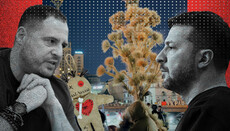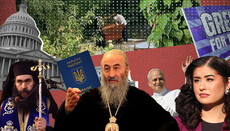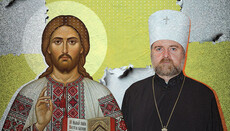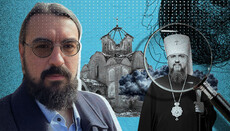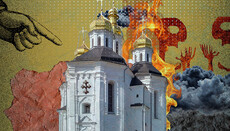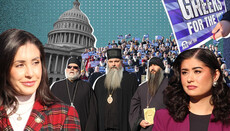OCU on Athos: why Ukrainian schismatics are received on the Holy Mountain
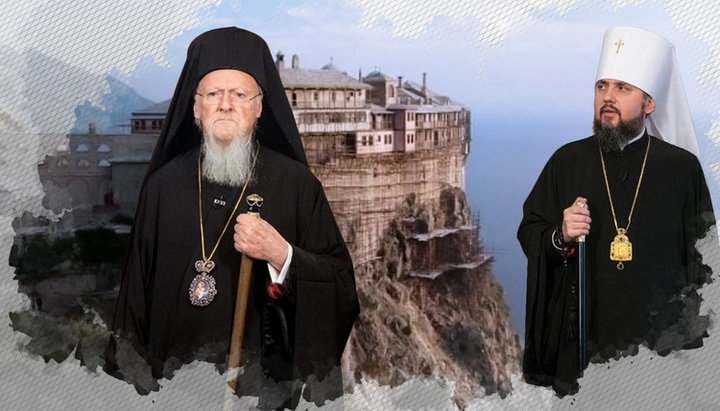
Why it became possible for the delegation of the OCU to concelebrate with monks of Mt. Athos and how Orthodox Christians should react to this.
The attitude of Orthodox Christians to Holy Mount Athos has always been special. And there is nothing surprising in this. We know, for example, that on Athos the Jesus prayer practically never stops. Athos is a home for shrines from the entire Orthodox world kept with great love and care. Here is the belt of the Virgin, the hand of John the Baptist, who touched the head of the Savior, the relics of Paul the Apostle and many other saints.
In addition, the Holy Mountain itself gave the world a huge number of great devotees and God-pleasers. Among them is St. Gregory Palamas, St. Nicodemus the Hagiorite, Sts. Silouan and Paisius the Athonite. But, most importantly, Athos is an abode of the Holy Mother, which She herself chose to glorify the name of Her Divine Son. The Mother of God is the Hegumeness of the Holy Mountain, and the abbots of all 20 monasteries that are located on the territory of the peninsula, only serve as external ministers in charge of monastic life.
That is why the faithful not only of Ukraine but of the entire Orthodox world, with great sorrow and pain, received the latest news from Mt. Athos that a group of Ukrainian schismatics dared to perform their “worship” in the abode of the Mother of God.
Chronicles of the Athos voyage of the schismatics
Despite the fact that some Athos monasteries explicitly promised to close the gates to the representatives of the OCU, the delegation of this organization, nevertheless, went to the Holy Mountain.
On February 8, 2019, “Bishop” Vasili Yuristy performed the first “liturgy” at the Pantocrator Monastery. The next day, another monastery of Athos, New Esphigmenou, received the schismatics. Later it became known that the leadership of the Vatopedi Monastery also made the decision to enter into communion with the dissenters. Needless to say, the representatives of the new "Church" of Ukraine enthusiastically accepted this event. “Our Folk on Mount Athos!” – a post with such a title appeared on the “Pomisna Tserkva” Facebook page, reporting that for the first time the “liturgy” of the OCU “bishop” was performed at the Pantocrator Monastery.
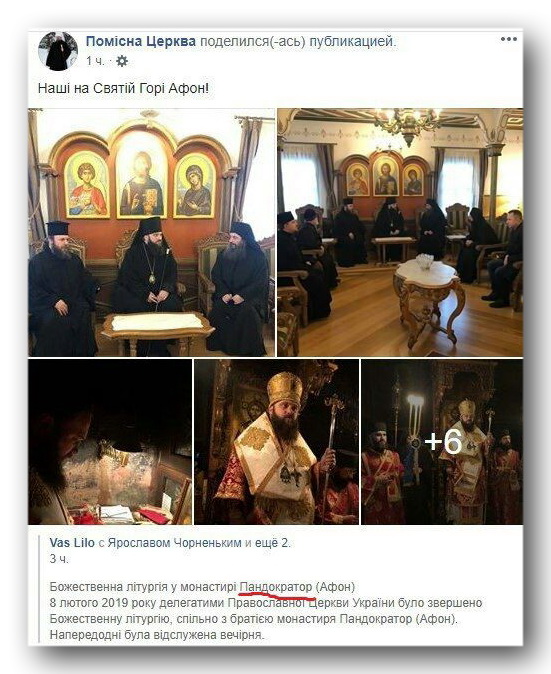
Exclamations of approval were also heard from neighbouring Russia, even from people who are hard to blame for the lack of critical thinking. But, as they say, no one has cancelled double standards. For example, Protodeacon Andrei Kuraev, after a visit of the schismatics to Pantocrator, wrote on LiveJournal that "Athos recognized the OCU". And despite the fact that Kinot, the governing body of the Holy Mountain, decided to refrain from making a judgment on the new Ukrainian “Church”.
At the same time, on Mt. Athos, there were also those who kept the schismatics out. The Russian Monastery of St. Panteleimon, the Greek Dochariou, and the Bulgarian Zographou close their doors to them. The hegumen of St. Panteleimon’s, Archimandrite Eulogius, explained to the members of the OCU delegation that the monastery did not recognize them as clerics and are not intended to do this in the future.
The Serbian Patriarch Irinej assured that the famous Hilandar Monastery on Mt. Athos will support those who oppose the arbitrary behaviour of the Phanariots: “I am sure that our brothers on Mount Athos are certainly with us, with their Church. I don’t think that they could take any other position different from that of our Serbian Church.”
Why Yuristy?
A separate question – why did Patriarch Bartholomew choose Vasili Yuristy, not the more eminent and honoured “hierarch” of the UOC KP, to implement his plans?
On January 5, the Patriarch of Constantinople signed the Tomos on "autocephaly" of the so-called Orthodox Church of Ukraine. Naturally, both his advisors and he were well aware that there would be a lot of problems with the newly-created “Church”. However, the Phanar considered that the majority of these problems will relate to the relations between the Constantinople and Moscow Patriarchates, while other Local Churches will either support the Phanariots or will not interfere.
However, everything turned out to be much more complicated. First, so far, no Local Orthodox Church has spoken out in support of the OCU. Secondly, many Churches have already explicitly stated that they do not recognize the new religious structure. Thirdly, because of the OCU, the Phanar runs the risk of spoiling relations not only with the ROC but also with the Serbian, Polish, Czech and other Churches. The situation is more than difficult. And the further, the more complicated it becomes. After all, having received no support from the Local Churches, the Phanar actually suffered a fiasco with respect to his popish claims. Therefore, the Patriarchate of Constantinople decided to seek the help of those who, one way or another, depend on it — the Athonites.
It has long been talked about Patriarch Bartholomew’s intentions to send a delegation of the OCU to the Holy Mountain. It was rumoured that the former UOC Metropolitan Alexander (Drabinko) was to visit Mt. Athos as a representative of the new “Church” of Ukraine. However, he did not go. There can be several reasons, one can only assume that the main thing was the absence of blessing from Patriarch Bartholomew – a more compromise figure was needed.
And it was found in the person of Vasili Yuristy. The fact is that neither the defector Metropolitan of the UOC, nor any of the serious representatives of the OCU fit this role. Indeed, in case of failure, this trip would finally undermine the position of Patriarch Bartholomew.
This is how Vladimir Legoyda, Chairman of the Synodal Department for Church Relations with Society and Mass Media of the Moscow Patriarchate, comments on Yuristy’s voyage to Athos: “In early February, a delegation of the sectarian alliance of the OCU, headed by a certain Pavel Yuristy, who considered himself a bishop, arrived at Mount Athos. The task of the sectarians was to assert themselves by performing a religious service jointly with the most loyal to Istanbul abbots of monasteries. The Phanar decided to test the Athos moods by this false bishop from the Kiev Patriarchate, who became a headliner only due to such use. After all, if the “very” Epiphany had been received on Athos by so few significant monasteries as Mr Yuristy was, it would have demonstrated too clearly the real authority of the Istanbul Patriarch on Athos, which rests only on the intrigues and patronage of the well-known Western Power.”
Most likely, only by this visit, Yuristy will go down in the history of the Church to open a new sad page.
Path of schism
A significant part of the Athonites have already quite clearly testified to their allegiance to Orthodoxy and refused to communicate with the Ukrainian schismatics. But it must be admitted that among the monks of the Holy Mountain there are those who do not see any problems in dealing with them.
We have already talked about the brethren of the Pantocrator and New Esphigmenou monasteries. But even earlier, Archimandrite Alexy, the hegumen of the Xenophontos Monastery, who participated in the "enthronement" of Epiphany, had taken the path of schism. Metropolitan Agafangel of Odessa, who has known Archimandrite Alexy for many years, sent him a letter in which he appeals to his fellow clergyman not to become a schismatic and reminds that whoever serves with a schismatics becomes one.
Bishop Ambrose (Yermakov) of Vereya spoke more radically about the Xenophontos and Pantocrator brethren: “I think we find important to have such a list of hierarchs, monasteries and parishes, which advocated the legalization of schismatics and entered into prayer and Eucharistic communion with dissenters having no spiritual order. Today the Athos Monastery of Pantocrator, following the Xenophon Monastery, which joined with the schismatics, is added to this list.” According to him, these two Athos monasteries voluntarily removed themselves from the Church's body, just as "during the times of Soviet godlessness, the Renovationists made themselves alien to the Church of Christ".
In turn, the spokesperson for the UOC Protopriest Nikolai Danilevich believes that such a position of some of the monasteries of the Holy Mountain leads to the “desacralization of Athos” in the eyes of believers: “The participation of some Athos monks in the ‘enthronement’ of the head of the new quasi-church structure, and now the open reception and concelebration of the Pantocrator brethren with a group of schismatics leads to the desacralization in the eyes of the UOC faithful of Athos as a stronghold of canonicity, loyalty and devotion to the Church. At least, this is how it is taken or used to be taken in our Church.”
Spiritual oasis
There is a pearl of good popular wisdom: if you do not want to be disappointed – do not get enchanted. No matter what anyone says about the Holy Mountain, but the fact remains that people live there too. People who have their own spiritual weaknesses and problems, passions and sins. Therefore, do not be surprised at what is happening.
Moreover, even 2,000 years ago, the Lord Jesus Christ warned His disciples: a time will come when there will be many temptations and divisions among them. And the history of Christianity in general and the Holy Mountain, in particular, has repeatedly confirmed the words of the Savior.
Indeed, very often it seems that Athos is a kind of fairy-tale island inhabited by the righteous. This pious myth is so deeply rooted in the consciousness of the Orthodox Christians of Ukraine, Russia and other Slavic countries that even the slightest attempt to dethrone it can cause a storm of anger. Yes, no one will ever argue that there have always been devotees of spirit and piety, zealots of faith and repentance on the Holy Mountain. In addition, Athos gave the world a huge number of theologians and beholders of the mysteries of God. But this does not mean in any way that there were no heretics or dissenters and people obsessed with various passions – pride, avarice, man-pleasing, etc. Athos is a holy place, but sinful people can live there.
For example, in the time of St. Gregory Palamas, many Athonites supported the heresy of Barlaam and Acindynus, who argued the creaturehood of the Divine grace. It is no secret that a Catholic monastery existed on Mount Athos for a long time – right up to the XIII century. Therefore, it is not surprising that later, in the time of Mark of Ephesus, among the Athonites there were also those who advocated the union with Rome. Yes, the majority was against it, but ... On the Holy Mountain, there is a story of how the brethren of one of the monasteries performed a joint "service" with the Catholics.
Catholic trail on Mount Athos
In 1275, the Throne of Constantinople was taken by John XI Bekkos, who in his youth was a fighter against the Catholic heresy of Papism, but later, having matured, changed his point of view. It was he who began to implement the decisions of the Council of Lyon on the union of the Orthodox and Catholics. Patriarch John persecuted his opponents quite harshly — they were defrocked, deprived of their parishes and sees, while the most stubborn were sent into exile.
The Patriarch of Constantinople needed more than that, so he decided to seek the support of the Athonites. In that regard, in September 1280, he, together with representatives of the Holy See, went on a “pilgrim trip” to Athos - to “enlighten” the most conservative and isolated part of the monasticism that constituted the main opposing force. As always in such cases, “diplomatic measures” - bribes, promises and intimidation – were used. However, it was not possible to achieve any more or less serious results – most of the monasteries stopped commemorating Patriarch John, considering him a heretic.
A truly cruel and terrible deterrent against those who disagreed was chosen – the soldiers burned down the tower of the Zographou Monastery, which at that time hosted sick brothers of the monastery. They all died.
The atrocities continued in the Vatopedi Monastery: the abbot was chained and, after being tortured, was drowned in the sea, and another 12 monks were beheaded outside the gates of the monastery. The Iveron monks were also drowned.
But the Great Athos Monastery met heretic patriarch with appropriate honours – chanting and bell ringing. That was the only time when a joint liturgy with the Catholics was served on Mt. Athos.
This is not the end of the story. After a short time, the Hierodeacon of the Great Lavra, who concelebrated with the papists, according to the chronicler, “burned down like a candle in the fire of a fulminant illness,” just like the seven other hieromonks and monks who violated an oath to Orthodoxy. All of them were buried, as heretics, outside the monastery cemetery.
On Mt. Athos, there is a tradition according to which the relics of the reposed are dug out after some time. If they decayed and turned into yellow bones, the world received a saint. But if they remained incorruptible, then the deceased was a great sinner and must be prayed for especially hard. So, when the relics of the defector monks were dug up, the monastery brethren were horrified: they saw the “faces” of hell - black faces, hair and nails, which did not cease to grow all the time the remains stayed in the grave.
Ultimately, the bodies of four apostates, whose looks inspired the greatest horror, were hidden in one of the inaccessible caves, not far from the Lavra. And the black “relics” of the remaining three were transferred to the narthex (entrance room adjacent to the western side) of the tombs of the Holy Apostles – to enlighten future generations. In the XIX century, the terrible bodies of these heretics were lost.
However, on March 2, 1964, the monk Gabriel from Iveron testified to their existence: “And we came to a steep ravine, from one sight of which one can be horrified, and he tells me: ‘They are here’... Then we entered this abyss and then with great difficulty got out of it and literally at the fingertips, as they say, climbed five to six meters, and I saw a cave, we entered it, and there I saw a terrible sight: three human figures leaning on a rock, standing upright, dressed in robes, with their eyes open, the beard and hair of all the three were long and white, faces were black, and also the ends of the hands, fingers slightly curved toward the palm, the fingernails were from two to four inches, we could not make out the toenails as they were closed with socks and shoes. I wanted to touch them to make sure that those are real bodies, and not just dry skin and bones, but the confessor said: ‘Do not touch the traces of the Lord’s wrath’."
All these facts do not in any way offset the significance of the Holy Mountain for the entire Orthodox world. But at the same time, they are called upon to remind us that only one Lord Jesus Christ is sinless.
Division and temptations
As already mentioned, not all the monasteries of Athos accepted or will accept Ukrainian schismatics in the future. The first among those who closed the gates before the OCU delegation was the Monastery of the Holy Great Martyr Panteleimon. Later other Athos monasteries followed its example.
In the end, we can conclude that Patriarch Bartholomew, who justified his actions in Ukraine by wanting to unite the split Ukrainian society, achieved a completely opposite effect and not only stirred turmoil into the minds of the Orthodox Christians of our country but also split Athonites - those who commemorate him as their primate.
Yes, there are monasteries that supported their patriarch, but even in them, confessors can be found. There is information that seven of the Vatopedi monks left the monastery and joined the St. Panteleimon Monastery community. It happened on the day when the Church commemorates the New Martyrs and Confessors of Russia. It can be said that the seven monks who had left Vatopedi considered the salvation of the soul more important than all the benefits of the world that the richest monastery of Athos could offer to them.
We can assume that the division on the Holy Mountain will hardly be very disturbing to Patriarch Bartholomew. Just for the reason that it has already existed long enough, though not of such a scale, of course.
It is known that the brethren of the Esphigmenou Monastery of Athos do not commemorate Patriarch Bartholomew as their primate. Moreover, they consider the current Patriarch of Constantinople to be a heretic and a Philocatholic. The abbot of this monastery does not take part in the meetings of the Kinot of the Holy Mountain, and the monks themselves avoid a joint prayer with representatives of the rest of Athos brotherhood.
Some of the hermits of the island, who also refused to commemorate the Patriarch of Constantinople and interrupted their communion with the official monasteries of Athos, have a similar position.
In addition, it is known that immediately after the so-called Crete Council-2016, the Holy Kinot of Mount Athos received an open letter signed by about 60 Athonite monks. They condemned the Council as anti-Orthodox and “predatory” and demanded to stop the commemoration of Patriarch Bartholomew of Constantinople during services.
The authors of the letter stated that the Council officially legitimized the heresy of ecumenism and stressed that as a result of the signing of the council documents, non-Orthodox confessions (Catholics and Protestants) "finally achieved their goal of recognizing sects by the Churches." Since, based on the logic of the documents of the Crete Council (in particular on the text of the document “Relations of the Orthodox Church with the rest of the Christian world”), “the papacy, like other heretics, is recognized by the Churches, and not heresy.”
Then the open letter was signed by the monks of the Great Lavra, the monasteries of Vatopedi, Hilandar, Pantocrator, Koutloumousi, Stavronikita, Philotheus, monks and elders from the settlements of Karyes, Kapsala and various monasteries. In response to such a demarche, Patriarch Bartholomew demanded that they should be evicted from Mt. Athos.
Of course, Athos as the abode of the Blessed Virgin has always been a spiritual beacon for Orthodox believers all over the world, glorified by many saints. However, we must remember that even the holiest place cannot guarantee us spiritual perfection. Coming to Athos and becoming a monk, a person cannot “automatically" receive the wisdom and depth of the judgments of the saints who have shined here.
The opinion of the monks of the Holy Mountain on the problem of the Ukrainian schism is important but the Athonites can hardly tell us anything new.
The Gospel and the canons of the Holy Church are the same for both the hegumens of Athos monasteries and priests from remote villages of Western Ukraine, who are driven out of their own temples for firmness and faithfulness. And which should be a great authority for us – a monk who was afraid to lose his cell or a multi-child priest who was not afraid to find himself on the street with his large family?
In any case, no one will ever tell us words higher than the words of the Savior: “Blessed are those who are persecuted because of righteousness, for theirs is the Kingdom of Heaven. ... Rejoice and be glad, for your reward is great in heaven” (Matt. 5, 10, 12).
Of course, in order to experience all the greatness, extent and truth of these words during the persecutions, we need real faith. Faith, which can be obtained only in prayer that the grace of God will touch all the deluded, all doubters and all the tempted, and Christian love and reason will reign both on the Holy Mountain and throughout the Orthodox world.
